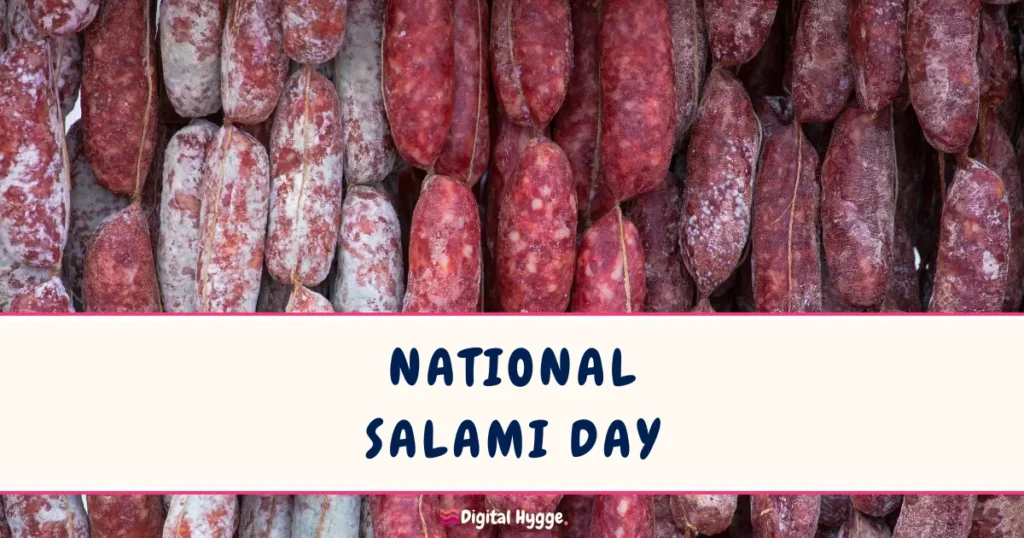National Salami Day, observed annually on September 7th, is a day dedicated to celebrating and enjoying one of the most beloved and historic types of cured meat: salami. This day encourages people to savor the rich, flavorful slices of salami in various forms, whether it’s as part of a sandwich, a charcuterie board, or simply as a snack. Salami’s enduring popularity stems from its versatility, rich taste, and the sense of tradition it brings to the table, often evoking memories of family gatherings and communal meals.
What is Salami and Its Origins?
Salami is a type of cured sausage made from fermented and air-dried meat, usually pork. Its preparation involves mincing the meat, seasoning it with spices like garlic and pepper, stuffing it into a casing, and then allowing it to mature over time. This curing process is crucial, as it not only preserves the meat but also enhances its flavor, making salami a delicacy enjoyed worldwide.
Origins of Salami
The story of salami is deeply rooted in history, particularly in Italy, where it originated. The word “salami” evolved from various terms used over the centuries, such as “salumen” in ancient Rome and “salamem” in the Middle Ages, all of which highlight the importance of salt in the preservation process. The tradition of making salami dates back to the time of the Etruscans and Romans and became more refined during the Middle Ages in Italy, where it developed into an art form.
Salami Worldwide
While salami has its origins in Italy, its popularity and methods of preparation have spread across the globe, with many countries developing their own unique versions of this beloved cured meat. Each region adds its own twist, using local spices, meats, and curing techniques, making salami a truly international delicacy.
🇮🇹 Italy
As the birthplace of salami, Italy boasts the most extensive variety of salami types, with each region offering its own specialty. For example, Salame Milano is known for its fine grind and delicate flavor, while Finocchiona from Tuscany is flavored with fennel seeds. Napoli Salami from southern Italy is spicier, reflecting the local preference for bold flavors.
🇪🇸 Spain
In Spain, salami-like sausages are often referred to as “embutidos.” One of the most famous varieties is Salchichón, a dry-cured sausage similar to Italian salami, seasoned with black pepper and sometimes garlic. Chorizo, although different in flavor due to its heavy use of paprika, is another popular Spanish cured sausage that falls within the same family as salami.
🇫🇷 France
The French version of salami, known as Saucisson, is another highly regarded cured meat. Saucisson is often coarser and thicker than Italian salami and can be seasoned with a variety of herbs, garlic, and even wine. Saucisson sec is a popular dry-cured version, often enjoyed with cheese and wine as part of a traditional French picnic.
🇩🇪 Germany
Germany produces several types of salami, with Cervelat being the most popular. German salamis are often smoked, giving them a distinctive flavor compared to their Italian counterparts. Teewurst is another type of spreadable German salami, typically eaten on bread as a savory snack.
🇭🇺 Hungary
Hungarian salami, particularly Pick Salami, is famous for its unique flavor, which comes from a special curing process that includes a blend of spices and a slow, cold smoking method. The result is a salami with a deep, smoky taste that is beloved in Hungary and beyond.
🇺🇸 United States
In the United States, Italian immigrants brought their salami-making traditions, leading to the creation of American varieties like Genoa salami and Hard salami. Genoa salami, named after the Italian city, is known for its garlic-forward flavor, while Hard salami is firmer and often smoked. These varieties are staples in American delis and are frequently used in sandwiches and charcuterie boards.
🌎 Other Countries
Countries like Poland, Russia, and even South Africa have their own versions of salami. For example, Kielbasa in Poland is a broad term for various types of sausages, some of which resemble salami. In South Africa, Droëwors is a dry sausage that shares similarities with salami but is typically made from beef.
Each of these regional varieties highlights how salami has been adapted to local tastes and traditions, making it a versatile and universally loved food. Whether it’s the spicy chorizo of Spain, the smoked Hungarian salami, or the garlic-infused varieties from Italy, salami continues to be a global favorite, celebrated not only on National Salami Day but year-round.
Before You Go:
We have many more national days lists for you to explore.
- Food-related national days: complete list of national food days, pasta & noodles days, vegan & vegetarian days, celiac & gluten-free days, mushroom days, ice-cream days, pizza days, coffee days, chocolate days, wine days, alcohol & drinking days.
- Non-food national days: National Days Calendar 2025-2026 (check out the printable calendars in my Etsy shop), National Days for Teachers, and a wide array of special lists such as cat days, dog days, animal days, cleaning & organizing days, book days, music days, family & relationships days, national days for women, stationery days and even Harry Potter days.
- Country-specific national days: Australian national days, more coming soon.






